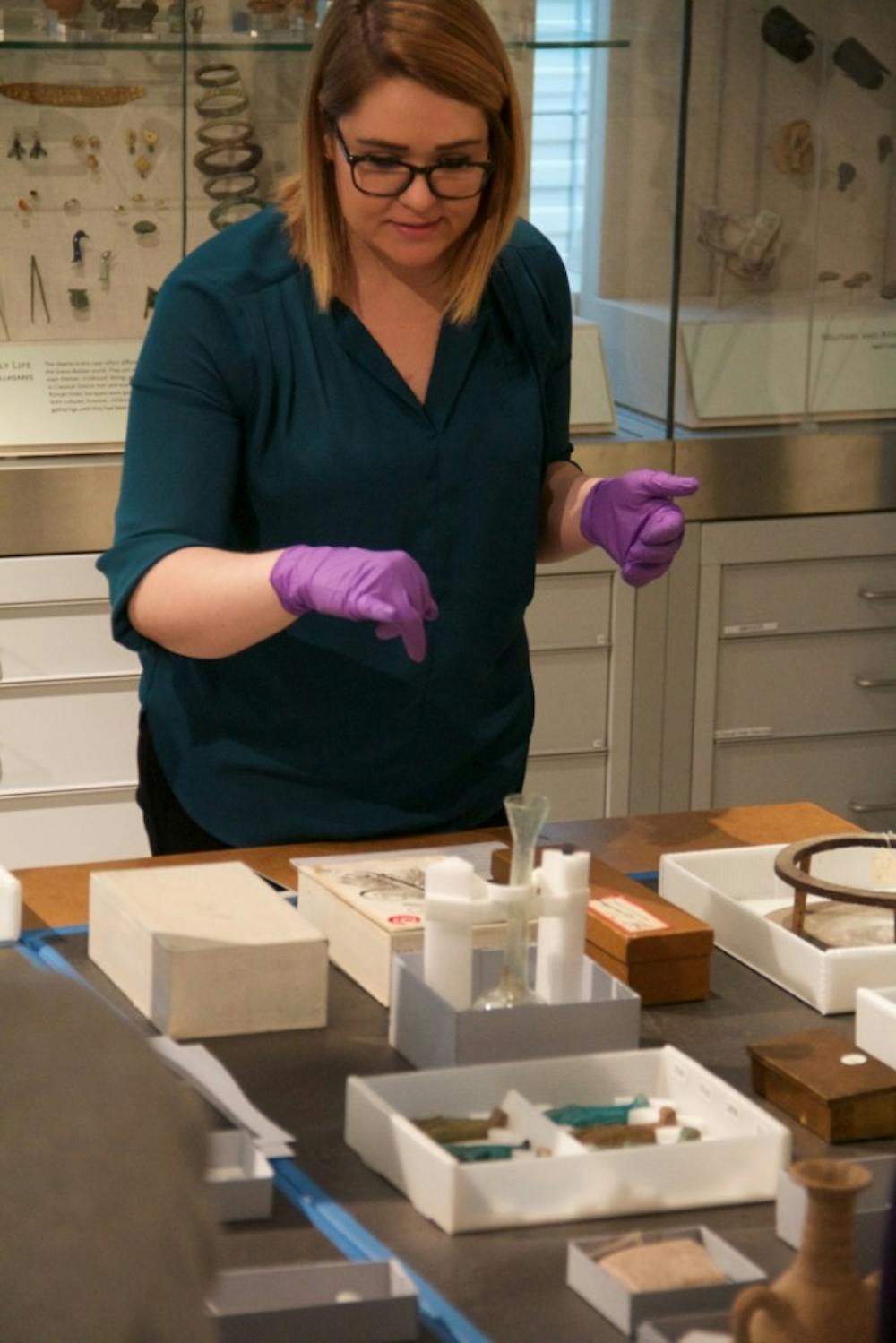By MARCIA ZIMMERMAN For The News-Letter
The Johns Hopkins University Archaeological Museum (JHUAM), located in the basement of Gilman Hall, hosted their monthly museum chat on Friday, spotlighting the work that goes into preserving the 130-year-old collection’s history.
Jennifer Torres and Kate Gallagher, two JHUAM Collections staff members, talked about rehousing, photographing and broader information tracking. This work is about the history of the objects themselves rather than what the objects represent.
Once an object becomes an artifact, it does not automatically become catalogued and stored perfectly to be preserved forever. Often, it’s left accumulating dust in a basement, displayed in a few different collections. Sometimes it’s cataloged incorrectly or slowly altered by varied interactions over time.
“One of the amazing parts about [working at JHUAM] is that I interact with the objects in a different way than I would in the field, because in the field everything is a lot more rough and tumble and the objects are approached differently,” junior Dane Clark, who works at the museum, said. “I can see an object’s importance as a historical object, with its actual use and its ongoing parts. I get to see the whole story, the other half not normally seen.”
During the event, Torres and Gallagher laid out particular archaeological treasures, mostly from ancient Egypt and Rome, which all had particularly interesting properties and stories within their recent history as an artifact and interaction with the Hopkins museum.
Once, the museum received an anonymous package in the mail from an address in a small town with priceless Egyptian and Roman artifacts. After finishing mountains of legal paperwork Gallagher recognized a piece the museum had been looking for: an amulet which had traces of the museum’s bright orange cataloging.
Many artifacts in the past had been lost due to lenient museum policies which allowed a researcher or anyone interested to check out an object for further study.
In addition different styles of inventorying can be a challenge. An Etruscan ladle from the late fifth century B.C. arrived broken, and because different categorical numbers were placed on the two halves, Gallagher had to find them using different inventory systems and recognize that the two were actually one singular object.
Torres talked more about how the way that objects have been stored throughout their lifetimes can create stories and add to the objects’ histories.
One of her favorite objects is a bronze metal box with Egyptian mummy wrappings inside. Normally the wrappings would be taken out of the box since they can damage each other, however they were kept together because that’s the way Hopkins received them. In the early 1900s the box was sent to the president of the University by a researcher in Egypt.
Because Torres works in rehousing the objects for the museum’s teaching collection, she takes the objects as they come to the museum and works both to preserve them and to keep them visible for teaching purposes.
“This museum is very unique because it is a teaching collection, which I have never worked with before,” Torres said. “It brought up new challenges, but I love working here... With a teaching collection objects are intended to be held, which is not what most museums would do, especially art museums.”
Students who study at the museum have to take quizzes that prove they understand how to work with fragile objects before they can touch them.
“Even when I am rehousing, that’s on the back of my mind: How can I minimize handling but also show what an object really is? The object’s visibility and also its accessibility are really important with a collection like this,” Torres said.
Torres’s attention to this factor shines through in her rehousing of the museum’s ancient Egyptian shabti figures. Originally they were all stored in one box, but Torres individually rehoused them so that teachers and researchers can pull one object out without disturbing the rest. In fact most objects in the collection are stored in drawers so that they can be studied interactively.
Another piece that exemplifies this idea is the head of a case that housed an ancient Egyptian mummy dated around 180 B.C. which is mounted in order to simultaneously display, store and protect it.
The entire outside and most of the inside of the object can be seen, which is special because even the marks from when the case was pressed onto the mummified body are visible.
“It’s an amazing thing because we can take all these objects out very easily and use them interactively to teach people. [Our teaching collection] is an experience hard to find anywhere else. [Students and researchers] get to learn in a more engaged way than just seeing pictures on a slide or a book. [They] get to see the objects in their own right,” Clark said.
That interactive quality shone through in this museum chat as well. Participants seemed to love getting to look closely at the objects and examine them as well as learn about their experiences in the world as artifacts. Many stayed after to discuss the stories in detail, ask questions and leaf through books that feature the objects in the collections.
Since the museum is open to the public, the event drew a few people unaffiliated with the University. Carole Cassano Silver once took a non-credit course at JHUAM and signed up for the email list to learn about upcoming events.
“I always find them fascinating,” Silver said. “Everything is very nicely presented. The people here know what they’re doing. I call it the ‘gem’ of [Hopkins]. I think it is really wonderful.”





